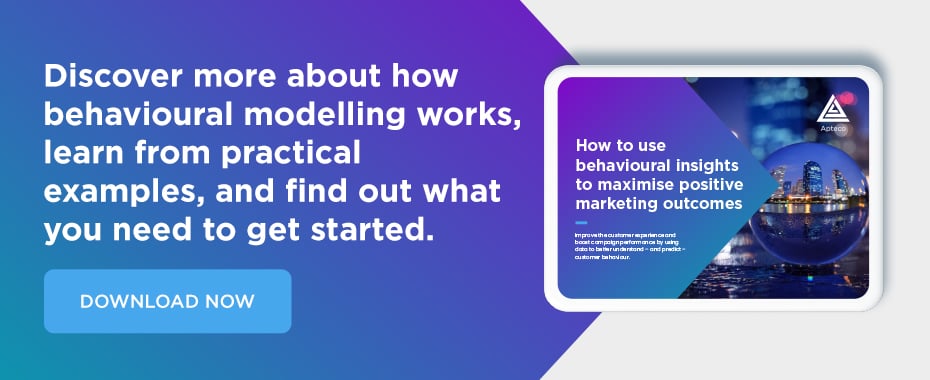A marketer’s crystal ball: how behavioural insights allow you to anticipate your customer’s next step
20 Jan 2022 | by Kristina Boschenriedter
3 min read
In this blog, we explain what behavioural modelling is, how it works, and its benefits for marketers and their wider businesses.
Whenever you communicate as a business with your customers, for example to promote a specific product offer, there are different options for how they can respond. They could immediately buy the product; they could see your communication but ignore it completely; they could see it and buy the product some weeks later; or they may never even notice your message.
You would hope for the first case, but with multiple different touchpoints and channels involved, customer journeys are usually anything but straightforward. How wonderful would it be if you could predict what each of your customers is most likely to do?
This is what behavioural modelling is all about. Behavioural modelling is an analytical method that marketers use to gain new behavioural insights about their customers, which in turn helps marketers not only to predict but also to actively influence customers’ future behaviour.
With these insights, marketers are able to promote positive outcomes and avoid negative behaviour and thus maximise the benefits for both their customers and their business.
What is behavioural modelling?
Marketers have a lot of tools and techniques that help them to measure “what” has happened. For example, how many visitors they had on their website in a certain time period, how many conversions they had or how many customers they have lost.
However, there are not many tools that help them really to understand “why” something has happened. Why customers have lapsed, why they converted or why they came to their website.
This is where behavioural modelling comes in. Behavioural modelling goes beyond describing what has happened and reveals the “why” behind customer actions. It is an analytical method that combines the two fields of customer journey analytics and predictive modelling.
This means that it goes beyond analysing and into predicting customer journeys. It builds the bridge between “what has happened” and “why has it happened” and allows marketers to move beyond insight into the realm of foresight.
Now we know what behavioural modelling is supposed to do, but how does it work?
How does behavioural modelling work?
Although it might sound a bit like magic, behavioural modelling actually follows a very structured, four-stage process:
1. Analyse
In the first stage, past customer behaviour is analysed to identify historical patterns over time. This reveals, for example, what behaviour a customers typically shows before they lapse. This could be a sequence of different events such as placing an order and calling the customer service desk, followed by a product return and, ultimately, churn of the customer.
2. Recognise
Once these patterns are identified, this knowledge is used to recognise similar patterns in today’s customers. In our example, this would mean that we identify those customers who have already placed an order, called the service desk and just returned the product.
3. Predict
In the next phase, we assign a score to our customers to predict their next step. Those with the highest scores have the most similar behaviour to our customers who lapsed and are also at risk of lapsing.
4. Steer
The knowledge gained from the three previous steps can now be used to steer the customer journey of these customers that are at risk of lapsing. As an example, we could send a voucher for these customers to avoid churn and improve their experience with our brand.
Behavioural data and communication data
This is the typical process that behavioural modelling follows. However, for demonstration purposes, our example about lapsing customers was rather simplified and the customer behaviour rather obvious.
There are usually a lot more so-called behavioural features that characterise a pattern, and they might be hidden deeper in your customer data than those just described in our example.
This is also what makes behavioural modelling challenging: behavioural modelling relies on transactional, time-dependent data that comes in two forms – behavioural data, and communication data. Behavioural data includes transactional events that are initiated by the customer. In contrast, communication data is initiated by your business.
Our graphic below shows examples of the different data types involved.

The challenge for marketing is to make sense of the patterns across multiple data sources that are intertwined in customers’ rapidly evolving timelines and that build the foundation for behavioural analysis.
Actively influence customer journeys
In conclusion, behavioural modelling isn’t easy, but it is an extremely powerful discipline allowing you to go beyond analysing to actively influencing each of your customer’s journeys.
If you would like to discover more about how behavioural modelling works, learn from practical examples, and find out what you need to get started, download our free eGuide “How to use behavioural insights to maximise positive marketing outcomes”.


